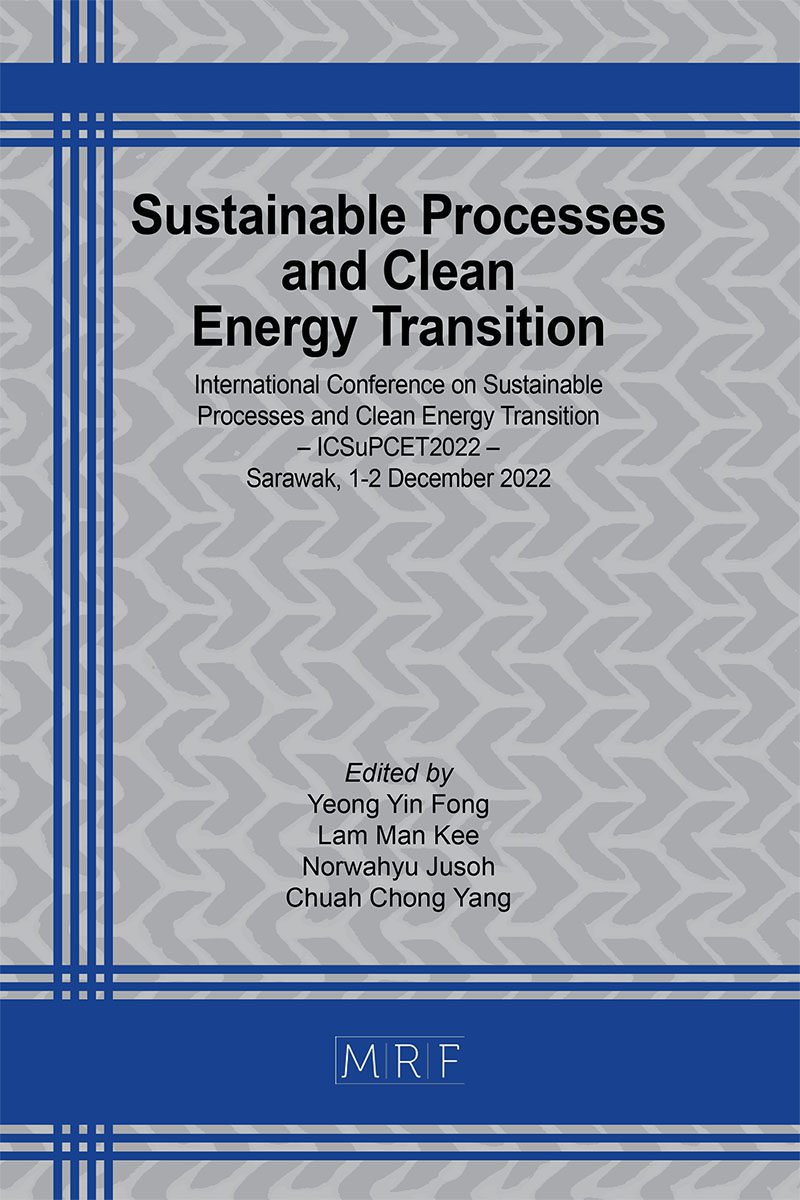Advanced thermo-chemical treatment of waste Bambusa Vulgaris for sustainable resource recovery
MUKESH Bhatt, KALPIT Shah, JYESHTHARAJ Bhalchandra Joshi, MADHURA Yadav, ABHISHEK Sharma
download PDFAbstract. Bambusa Vulgaris or Bamboo is one of the rapidly growing woody plants among different species and not being utilized properly around the world. Hence, the utilization of bamboo for sustainable resource recovery is required to avoid deforestation. This study is focused on thermo-chemical treatment of bamboo waste to investigate the physico-chemical properties of generated products. Experiments were carried out in semi batch, four zone electrically heated, rotary kiln reactor, with reaction time of 90 minutes and heating rate of 25 °C/min, for yield optimization. Products were analyzed through TGA, XRF, SEM/EDS, GCMS and FTIR. From the GCMS study, it was found that the bio-oil obtained through thermo-chemical treatment, contains high amount of alcohols, aldehydes, ketone and phenolic compounds. XRF of biochar showed 11 % inorganic components, among them K and Ca were found to be the major elements. XRF and EDS results were in good agreement and confirmed high carbon content. Biochar had the calorific value of 30.97 MJ/kg, which makes it suitable as energy source for commercial applications. Biochar contained carbonyl (C=O), hydroxyl (HO-), and carboxyl (HOOC) groups, which are responsible for ion exchange reactions during soil amendment. Low ash and high carbon content along with high porosity promotes its usage as high value material in different non-agricultural applications. Additionally, high amount of carbon is beneficial for maximizing the carbon storage and making the process environmentally sustainable.
Keywords
Biomass, Thermochemical conversion, Bio-Oil, Waste management, Biochar
Published online 5/20/2023, 9 pages
Copyright © 2023 by the author(s)
Published under license by Materials Research Forum LLC., Millersville PA, USA
Citation: MUKESH Bhatt, KALPIT Shah, JYESHTHARAJ Bhalchandra Joshi, MADHURA Yadav, ABHISHEK Sharma, Advanced thermo-chemical treatment of waste Bambusa Vulgaris for sustainable resource recovery, Materials Research Proceedings, Vol. 29, pp 192-200, 2023
DOI: https://doi.org/10.21741/9781644902516-22
The article was published as article 22 of the book Sustainable Processes and Clean Energy Transition
![]() Content from this work may be used under the terms of the Creative Commons Attribution 3.0 license. Any further distribution of this work must maintain attribution to the author(s) and the title of the work, journal citation and DOI.
Content from this work may be used under the terms of the Creative Commons Attribution 3.0 license. Any further distribution of this work must maintain attribution to the author(s) and the title of the work, journal citation and DOI.
References
[1] M.D. Burger, Evaluating different value adding processing systems for bamboo developments, (2018).
[2] A. Kumar, S. Shabnam, M.S. Malik, Doubling Farmers Income through Agroforestry, Scientific Publishers, 2021.
[3] S. Ross, Bamboo construction as a sustainable building technology from a structural and materials engineering perspective, (2021).
[4] X. Hu, M. Gholizadeh, Biomass pyrolysis: A review of the process development and challenges from initial researches up to the commercialisation stage, Journal of Energy Chemistry. 39 (2019) 109-143. https://doi.org/10.1016/j.jechem.2019.01.024
[5] A.J. Ridout, M. Carrier, F.-X. Collard, J. Görgens, Energy conversion assessment of vacuum, slow and fast pyrolysis processes for low and high ash paper waste sludge, Energy Conversion and Management. 111 (2016) 103-114. https://doi.org/10.1016/j.enconman.2015.12.043
[6] S. Fawzy, A.I. Osman, H. Yang, J. Doran, D.W. Rooney, Industrial bio-char systems for atmospheric carbon removal: a review, Environmental Chemistry Letters. 19 (2021) 3023-3055. https://doi.org/10.1007/s10311-021-01210-1
[7] A.N. Amenaghawon, C.L. Anyalewechi, C.O. Okieimen, H.S. Kusuma, Biomass pyrolysis technologies for value-added products: a state-of-the-art review, Environment, Development and Sustainability. 23 (2021) 14324-14378. https://doi.org/10.1007/s10668-021-01276-5
[8] T. Kan, V. Strezov, T.J. Evans, Lignocellulosic biomass pyrolysis: A review of product properties and effects of pyrolysis parameters, Renewable and Sustainable Energy Reviews. 57 (2016). https://doi.org/10.1016/j.rser.2015.12.185. https://doi.org/10.1016/j.rser.2015.12.185
[9] I.P. Woyinbrakemi, A.J. Gunorubon, A.O. Michael, Production and Characterization of Bio Oil from Bamboo, American Journal of Chemical Engineering. 9 (2021) 134. https://doi.org/10.11648/j.ajche.20210906.11
[10] J. Zhang, J. Li, D. Ye, X. Zhu, Q. Liao, B. Zhang, Tubular bamboo charcoal for anode in microbial fuel cells, Journal of Power Sources. 272 (2014) 277-282. https://doi.org/10.1016/j.jpowsour.2014.08.115
[11] L. Zhao, X. Cao, O. Mašek, A. Zimmerman, Heterogeneity of bio-char properties as a function of feedstock sources and production temperatures, Journal of Hazardous Materials. 256 (2013) 1-9. https://doi.org/10.1016/j.jhazmat.2013.04.015
[12] T. Stedile, L. Ender, H.F. Meier, E.L. Simionatto, V.R. Wiggers, Comparison between physical properties and chemical composition of bio-oils derived from lignocellulose and triglyceride sources, Renewable and Sustainable Energy Reviews. 50 (2015) 92-108. https://doi.org/10.1016/j.rser.2015.04.080
[13] L.E Hernandez-Mena, A.A. Pécoraa, and A.L., Beraldob,. Slow pyrolysis of bamboo biomass: analysis of bio-char properties. Chemical Engineering transactions, 37(2014), 115-120.
[14] H. Wang, X. Wang, Y. Cui, Z. Xue, Y. Ba, Slow pyrolysis polygeneration of bamboo (Phyllostachys pubescens): Product yield prediction and bio-char formation mechanism, Bioresource Technology. 263 (2018) 444-449. https://doi.org/10.1016/j.biortech.2018.05.040
[15] H.C. Lin, Preliminary Safety Evaluation of Bamboo Pyrolysis Products: Charcoal and Vinegar, in: Bamboo-Current and Future Prospects, IntechOpen, 2017. https://doi.org/10.5772/intechopen.68542
[16] Y. Hou, Z. Feng, Y. He, Q. Gao, L. Ni, M. Su, H. Ren, Z. Liu, W. Hu, Co-pyrolysis characteristics and synergistic interaction of bamboo residues and disposable face mask, Renewable Energy. (2022). https://doi.org/10.1016/j.renene.2022.05.111
[17] D. Zhang, J.B. Ji, C.F. Song, S.D. Shan, Catalytic Pyrolysis of Bamboo Residues for Composite Bio- char and Bamboo Oil, in: Applied Mechanics and Materials, Trans Tech Publ, 2014: pp. 921-925. https://doi.org/10.4028/www.scientific.net/AMM.472.921
[18] M. Bhatt, S. Wagh, A.G. Chakinala, K.K. Pant, T. Sharma, J.B. Joshi, K. Shah, A. Sharma, Conversion of refuse derived fuel from municipal solid waste into valuable chemicals using advanced thermo- chemical process, Journal of Cleaner Production. 329 (2021) 129653. https://doi.org/10.1016/j.jclepro.2021.129653
[19] G. Lyu, S. Wu, H. Zhang, Estimation and comparison of bio-oil components from different pyrolysis conditions, Frontiers in Energy Research. 3 (2015) 28. https://doi.org/10.3389/fenrg.2015.00028































